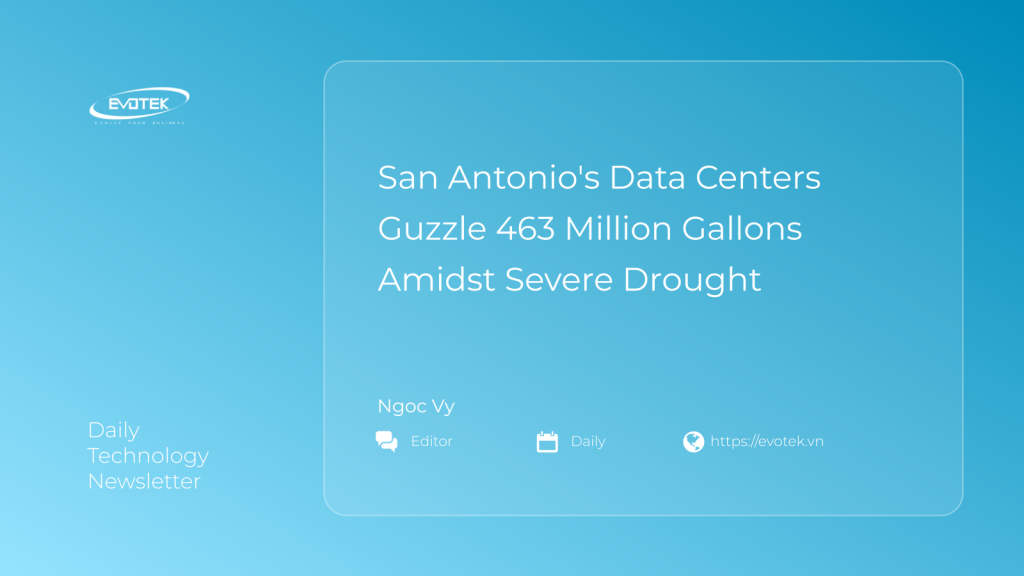As San Antonio grapples with the severe effects of prolonged drought and residents face strict water conservation rules, two prominent data centers in the area have consumed a staggering 463 million gallons of water over 2023 and 2024. This colossal usage, equivalent to the water needs of tens of thousands of local households, stands in stark contrast to the sacrifices made by the community.
According to a recent study by the San Antonio Water System (SAWS), facilities operated by tech giant Microsoft and the Army Corps in the Alamo City were responsible for this significant water drain. This revelation comes at a time when SAWS is enforcing Stage 3 watering rules, limiting residents to watering their lawns just once per week on a designated day. Homes exceeding 20,000 gallons of water usage also incur additional surcharges, highlighting the urgent need for conservation.
“While surprise rains generated some green around San Antonio, they did not bring us out of drought,” a SAWS blog post from July 1 stated. “It will take many more steady rainfalls to overcome the last five years of less-than-adequate rain.”
Unregulated Consumption for AI Powerhouses
Despite the critical water situation, these data centers, which power resource-intensive generative AI models, have operated without any water usage restrictions. Although the Texas Legislature passed a bipartisan bill in its most recent session to divert energy from data centers during extreme weather outages, there were no legislative measures enacted to regulate their substantial water consumption.
The issue extends beyond San Antonio. A recent investigation by the Austin Chronicle revealed that Central Texas data centers consume millions of gallons daily. Midsized facilities can use approximately 300,000 gallons per day, while larger centers may consume as much as 4.5 million gallons daily. Austin alone hosts 47 data centers, and the Dallas-Fort Worth area leads the state with 189 facilities.
Projections by the Houston Advanced Research Center (HARC) estimate that data centers statewide will collectively use 49 billion gallons of water this year. This water is primarily used to cool the powerful, heat-generating computers essential for their operations.
The Stargate Project: A Looming Water Challenge
Further escalating the demand on natural resources is the ambitious Stargate Texas data center project near Abilene. Broke ground last year by OpenAI CEO Sam Altman, and announced by former President Donald Trump in January, this $500 billion venture is set to become the world’s largest data center.
Spanning an area 60 acres larger than Central Park, Stargate is projected to require enough energy to power 750,000 homes, alongside being a massive drain on the local water supply. Its location in an already “very water-stressed” landscape raises significant concerns about environmental sustainability.
Margaret Cook, a water policy analyst at HARC, expressed alarm to Techie + Gamers magazine, stating, “These centers are showing up in places that are very water-stressed. There’s no requirement for them to have conversations with communities about how much water they’ll use.”
Future Water Scarcity Concerns
The rapid expansion of data centers across Texas is set to compound these challenges. The Austin Chronicle reports that their numbers are expected to multiply tenfold across the Lone Star State by 2030. HARC’s estimates suggest that by then, data center water consumption could reach a staggering 399 billion gallons annually, accounting for 6.6% of Texas’s total water use.
This escalating thirst, coupled with the water demands of a rapidly growing population, poses a significant threat to water reserves intended for future generations. “So, any of these communities that are allowing data centers in their community are gambling against being able to get new water from future state water plans, from future funding cycles,” Cook warned. “They’re using up the water that was allocated to their population for the future.”

 日本語
日本語 한국어
한국어 Tiếng Việt
Tiếng Việt 简体中文
简体中文